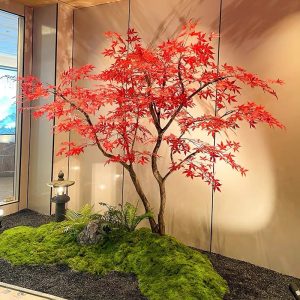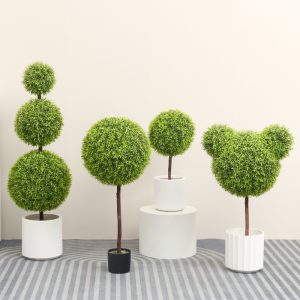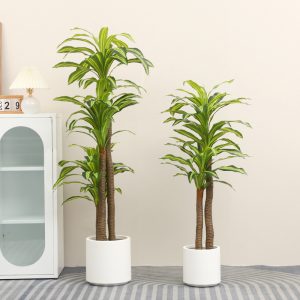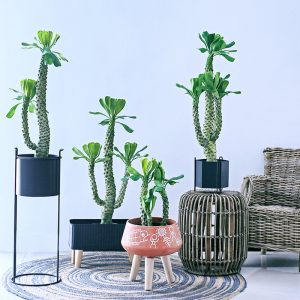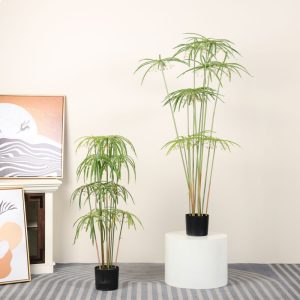On the first Saturday of September 2025, just half an hour after the Grove Shopping Mall in Los Angeles opened its doors, sunlight streamed through the glass dome and spilled over the wooden benches in the atrium. The air carried the aroma of cinnamon rolls mixed with vanilla fragrance. As my colleague Emma and I walked through the entrance, we were immediately drawn to the scene before us—standing tall in the once-empty atrium were four 3-meter-high artificial camphor trees, their dense leaves casting dappled shadows. Near the children’s area, two rows of artificial maple trees glowed with warm orange and red tones in the sunlight, as children laughed and played beneath them.
“Oh my, it feels like an entirely new place!” Emma exclaimed, hurrying to the trees. Running her fingers along the leaves and bark, she asked in surprise, “Are these real trees? They look so natural!”
Handing her an iced Americano, I explained: “These aren’t natural trees—they’re part of the mall’s bulk artificial tree procurement solution for shopping centers. You know how the mall previously tried real trees; they either got scorched by the sun or battered by heavy rain, making maintenance costs skyrocket. Switching to large-scale artificial trees bulk order has solved all those problems at once.”

Just then, mall operations manager Mike walked over with a traffic report: “Thank you so much for this solution! This morning’s visitor numbers are up 30% compared to last week. Many guests even stopped to take photos in the atrium. In the past, fallen leaves from real trees caused complaints, but now everything is worry-free—and the trees have become a new attraction.”
In the sunlight, the children’s zone with its artificial maple trees looked especially warm. Emma bent down to watch the kids brush against the leaves, remarking: “These feel so real, nothing like the overly glossy fake trees you usually see. How did you choose the styles?”
I pointed toward the food court passage lined with artificial fiddle leaf fig trees and explained: “When designing a shopping mall artificial tree wholesale plan, we customize based on each functional zone. The atrium needs grandeur, so we chose 3-meter camphor trees with metal bases; the children’s area uses orange-red maple trees to create a cozy atmosphere; and the food court, where light is limited and real plants struggle, has 1.2-meter fiddle leaf fig trees to brighten the space without taking up much room.”
Emma nodded, closely observing the vein details on the leaves. “Even the branch patterns are so delicate, and the ceramic pots coordinate perfectly with the dining area,” she said. Mike added: “We enhanced the bases with wooden planters and artificial moss, making them more natural-looking. Some visitors even asked if they could buy the same models for their gardens.”
In the beauty zone’s lounge, two small artificial lemon trees added fresh yellow accents to wicker chairs, instantly becoming a selfie hotspot. Snapping a picture, Emma remarked: “This zoning-based approach is so practical—we could definitely recommend it to our mall client in Miami.”
Indeed, “zonal customization + bulk purchasing” has become the core demand of European and American B2B malls. With vast areas and diverse sections, from atriums to children’s corners, each zone requires a unique atmosphere. Through bulk artificial tree procurement, malls can reduce per-unit costs while avoiding monotonous, repetitive layouts.
The savings are significant. For example, in this project, a single 3-meter artificial camphor tree would cost $300, but in bulk the price was just $180. A 1.8-meter maple tree priced individually at $150 dropped to only $90 in bulk, with free installation and design services included. Compared to piecemeal purchases, the integrated solution cut nearly 40% of the budget.
Mike added: “Previously, we spent $2,000 per month on gardeners to maintain real trees. Now, our cleaning staff just wipes them down—saving over $20,000 annually.”
In the afternoon, Lily, a procurement manager from Chicago, remarked after her inspection: “This kind of comprehensive artificial tree solution for shopping malls is exactly what we need! Other suppliers only offer fixed models, but your one-stop service from design to installation is far more convenient.”
By sunset, the leaves of the artificial camphor trees glowed golden. Emma sighed: “No wonder more and more malls in Europe and the U.S. are choosing bulk artificial tree solutions—they save money and effort while elevating the atmosphere.”
Mike agreed: “For us, this isn’t just a décor upgrade—it’s a traffic booster. Guests stay longer, and their willingness to shop naturally increases.”
In fact, a mall on Fifth Avenue in New York created a “Winter Forest” with a mass artificial tree procurement plan, boosting traffic by 40%. A Miami mall placed artificial palm trees on its terrace, turning it into a social media hotspot. Clearly, the value of these solutions goes beyond “beauty” and “low maintenance”—they help malls build distinctive landscapes, enhance consumer experiences, and drive real sales.
If your shopping center struggles with landscaping—worrying about the upkeep of real trees, inconsistent design styles across zones, or budget overruns—then a complete artificial tree wholesale solution for malls may be the ideal choice. With one-time investment, your mall stays evergreen, offering guests a comfortable, nature-inspired shopping experience.








